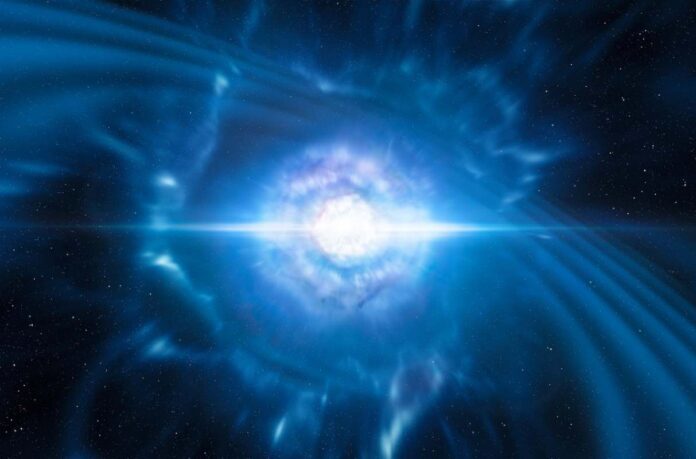Astronomers have successfully traced a remarkably bright gamma-ray burst (GRB) back to its origin using the James Webb Space Telescope (JWST). Their findings reveal that the GRB was the result of a violent collision between two neutron stars, known as a “kilonova.” These cosmic collisions not only produce long-duration GRBs but also serve as the birthplaces of the universe’s heaviest elements, which cannot be created within the cores of stars.
The formation of these heavy elements occurs through a process called “neutron capture” or the r-process, where atomic nuclei capture neutrons, leading to the creation of new and heavier elements such as gold, platinum, and uranium. The r-process can only occur under extreme and violent conditions, precisely the circumstances surrounding colliding neutron stars.
This marks the first time that JWST has been utilized to detect emissions from such an event. Moreover, the powerful space telescope was able to identify the signature of heavy elements being forged during this explosive event. Notably, the researchers observed evidence of the heavy element tellurium and the production of lanthanides, a group of 15 metals heavier than lead.
The team of astronomers, led by Andrew Levan from Radboud University in the Netherlands, expressed the significance of their findings in a paper. They emphasized that these observations demonstrate the ability of GRBs to generate r-process elements across a wide range of atomic masses, thus playing a vital role in the formation of heavy elements throughout the universe.
The GRB that led the team to the kilonova source, designated GRB 230307A, is extraordinary in its own right. Initially detected by NASA’s Fermi Gamma-ray Space Telescope on March 7, 2023, it is the second-brightest GRB ever observed. The GRB lasted approximately 34 seconds and was observed by multiple telescopes, enabling astronomers to pinpoint its source through triangulation.
Brian Metzger, a member of the team from Columbia University, shared their achievement on Twitter, noting that the kilonova emission was detected by JWST following the GRB. This discovery challenges previous assumptions about the duration of the central engine’s “jet” in a neutron star merger, as the burst lasted longer than expected.
JWST observed the kilonova on two occasions, first at 29 days after the GRB and then again at 61 days after the initial burst of radiation. The rapid decrease in brightness and the color transition from blue to red between these observations provided evidence of its kilonova nature.
The team identified several bright galaxies in close proximity to the kilonova, any of which could potentially host the neutron star collision and serve as the source of GRB 230307A. Among these galaxies, they favor the brightest one, located around 8.3 million light-years away from Earth, and approximately 130,000 light-years offset from the GRB source.
Aside from light emissions, the kilonova might have been detectable through gravitational waves, which occur as a result of the collision of neutron stars and cause ripples in space-time. However, the Laser Interferometer Gravitational-Wave Observatory (LIGO), capable of detecting these waves, was offline for upgrades during the time GRB 230307A occurred and only resumed operations in May 2023.
The team’s discovery is currently undergoing peer review before being published in a scientific journal. An initial version of their paper is available on the arXiv research repository, although it may undergo revisions.
Reference:
A. Levan, B. P. Gompertz et. al, JWST detection of heavy neutron capture elements in a compact object merger, High Energy Astrophysical Phenomena (astro-ph.HE); Cosmology and Nongalactic Astrophysics, arXiv:2307.02098

[…] age of our universe and by the discovery of early galaxies in an advanced state of evolution made possible by the James Webb Space Telescope. These galaxies, existing a mere 300 million years or so after the Big Bang, appear to have a level […]
best site for good information. and this is recomended for good promo for make money depo 25 bonus 25
jangan lupa untuk menggunakan kode promo depo 25 bonus 25